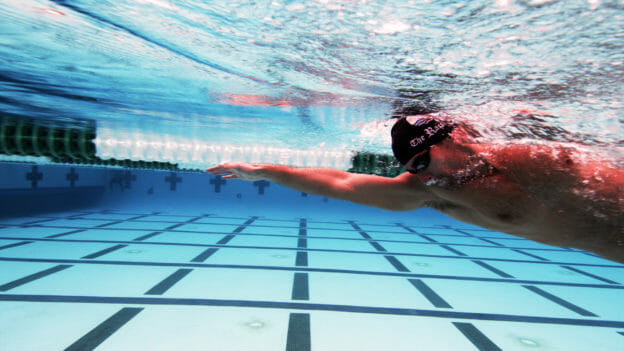High Octane vs Low Octane in the Sprint Freestyle
In watching the men’s and women’s 50 meter sprint freestyle events in the Tokyo Olympic Games, many of the athletes recover their arms with them straight or nearly straight and in a more vertical, rather than horizontal, position. As we have described often, both the length of the recovering arm and downward speed of the recovering arm impact the propulsion generated from the underwater pulling hand. Further, by recovering the arm vertically more than horizontally, the shoulders of the swimmer rotate faster to reach the same recovering position with the other arm, and gravity helps to bring the arm down faster.
The speed of the downward motion of the arm, the length of the downward moving arm and the speed of the swimmer’s shoulder rotation are considered coupling motions, and can potentially increase the power and speed of the swimmer in the water.
Recently, we used our Velocity Meter (VM) technology to test the speed of elite freestyle sprinter, Payton Sorenson, in Coronado. Payton has historically used a low to medium octane recovery on his 50 meter freestyle sprint technique, bending his elbows considerably on his arm recovery. Over ten meters, after his breakout, we compared his average speed of his sprint freestyle using his traditional low octane and again, using a straight arm, high octane freestyle technique.

Elite sprinter, Payton Sorenson, using high-octane freestyle recovery. Velocity curves above, Acceleration curves below
While he admitted that using a straight arm recovery felt weird to him, Payton did manage to swim slightly faster using that technique. The difference was very slight, 2.00 m/sec with straight arm vs. 1.99 m/sec with bent arms. Over approximately 19 seconds of swimming (after the breakout) in the race, that amounts to .18 meters, or about 7 inches of difference.
Since we tested Payton just a few weeks before the Olympic Trials, he understandably decided not to make the change to high octane freestyle for the 50-meter sprint. We would never recommend making a significant change in technique that close to major competition. He recorded a PB in the prelims and made the semi-finals, but missed making the finals by .1 seconds.
Would he have made the finals with a high-octane recovery? We will never know. But we do know that he is now intrigued enough with this new freestyle technique to keep trying it out. Perhaps someday soon, he will gain those 7 inches and go that sub 22.0 second 50 meter sprint time that he dreams of swimming.
Check out the VM study we did on Payton’s recovery technique in this week’s Race Club video release.
Yours in Swimming,
Gary Sr.

